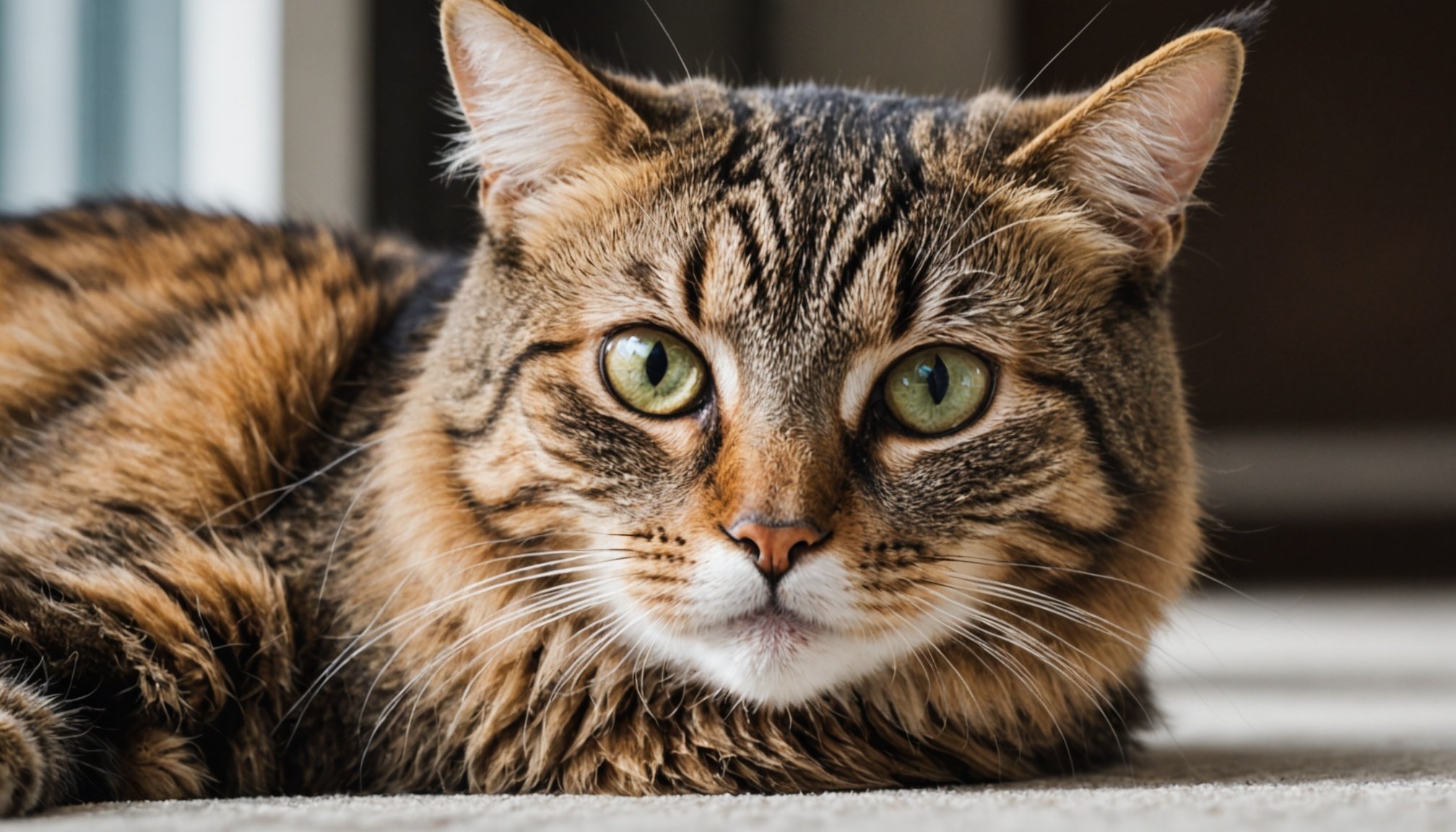Identifying Early Arthritis Symptoms in Senior Cats: A Comprehensive Guide for Pet Owners
As your feline friend ages, it's essential to be vigilant about the health changes they may experience. One of the most common and debilitating conditions affecting senior cats is arthritis. In this guide, we will delve into the world of cat arthritis, exploring its causes, symptoms, and the various ways you can help your senior cat live a more comfortable and active life.
Understanding Arthritis in Cats
Arthritis, specifically osteoarthritis (OA), is a degenerative joint disease that affects the joints of your cat. It occurs when the protective cartilage in the joints begins to deteriorate, leading to pain, inflammation, and reduced mobility. This condition can impact any joint in the body, but it most commonly affects the elbows, knees, hips, and spine.
A lire également : Is It Possible to Maintain a Bee Colony in Your London Garden? A Complete Guide to Urban Beekeeping
Causes of Arthritis in Cats
Arthritis in cats can develop due to several factors:
- Age: As cats get older, the wear and tear on their joints increases, making them more susceptible to arthritis. Typically, cats over the age of 7 start to show signs of aging, including joint degeneration.
- Genetics: Some breeds are more prone to arthritis due to their genetic makeup. However, this is less common in cats compared to dogs.
- Lifestyle Factors: Obesity, previous injuries, and excessive use of certain joints can all contribute to the development of arthritis. For instance, a cat that has been overweight for a long time may experience more joint stress, leading to arthritis.
- Other Health Conditions: Conditions like kidney disease, dental disease, and hyperthyroidism can also contribute to the development of arthritis or exacerbate its symptoms.
Recognizing the Signs of Arthritis in Senior Cats
Identifying arthritis in your senior cat can be challenging, but there are several key signs and symptoms to look out for:
Dans le meme genre : Is It Safe for Dachshunds to Compete in Dog Sports Without Back Injury Risks?
Common Symptoms of Arthritis in Cats
- Avoiding Stairs and Jumping: If your cat suddenly stops using the stairs or avoids jumping onto high places, it could be a sign of joint pain. This is often due to osteoarthritis, which makes climbing and jumping uncomfortable.
- Weight Changes: Weight loss or gain can be indicative of various health issues, including arthritis. Cats in pain may lose their appetite, leading to weight loss, or they may gain weight due to reduced activity.
- Litter Box Problems: Senior cats with arthritis may have difficulty using the litter box, leading to accidents outside of it. This could be due to pain when squatting or standing up.
- Changes in Sleep Patterns: While older cats sleep more, excessive sleeping or difficulty finding a comfortable position can indicate pain. Conversely, some cats may sleep less due to discomfort.
- Grooming Changes: Cats are meticulous about their grooming. If your cat's grooming habits slow down or stop, it might be because the bending and twisting required for grooming is too painful.
Detailed List of Symptoms
Here is a more detailed list of symptoms to watch for:
- Limping or Favoring One Leg: If your cat starts limping or seems to avoid putting weight on a specific limb, it could be a sign of arthritis.
- Stiffness After Rest: Cats with arthritis often show stiffness after resting, which diminishes as they start moving and warming up.
- Lethargy and Poor Appetite: Pain and discomfort can lead to lethargy and a decrease in appetite.
- Grumpiness or Aggression: Cats in pain may become more irritable or aggressive.
- Excessive Vocalization: Increased meowing or other vocalizations can be a sign that your cat is in pain.
Diagnosing Arthritis in Cats
Diagnosing arthritis in cats involves a combination of physical examination, medical history, and diagnostic tests.
Physical Examination
A veterinarian will perform a physical examination to check for joint deformity, fluid in the joints, instability, or restriction of movement. They may also palpate the joints to check for pain or discomfort and look for signs of muscle atrophy or joint swelling.
Diagnostic Tests
Diagnostic tests such as radiographs (X-rays) can help confirm the presence of arthritis. These tests can show joint degeneration, bone spurs, and other changes associated with arthritis.
Managing and Treating Arthritis in Senior Cats
While there is no cure for arthritis, there are several ways to manage the condition and improve your cat's quality of life.
Medications and Pain Relief
- NSAIDs: Nonsteroidal anti-inflammatory drugs (NSAIDs) are commonly prescribed to manage pain and inflammation in cats with arthritis. However, these medications must be used carefully due to potential side effects such as stomach ulcers, kidney or liver problems.
- DMOADs: Disease-modifying osteoarthritis drugs (DMOADs), like Adequan, can provide relief from joint pain by enhancing the health of critical components within the joints. These are often used in conjunction with other treatments.
- Solensia: This is an FDA-approved once-monthly monoclonal antibody therapy specifically designed to control osteoarthritis pain in cats. It works by diminishing pain signals, restoring mobility and improving the cat's overall quality of life.
Lifestyle Changes
Making a few lifestyle adjustments can significantly help your senior cat with arthritis:
- Easy Access: Ensure your cat has easy access to food, water, litter boxes, and favorite resting spots. This can involve moving these essentials to a more accessible location or using ramps for easier mobility.
- Weight Management: Maintaining a healthy weight can reduce the stress on your cat's joints. Consult with your veterinarian to develop a weight management plan if necessary.
- Comfortable Environment: Provide a comfortable environment by ensuring your cat has warm, soft places to rest. Orthopedic beds can be particularly beneficial for cats with arthritis.
Alternative Therapies
- Physical Therapy: Gentle exercises and physical therapy can help maintain your cat's mobility and strength. Consult with a veterinarian or a certified animal physical therapist to develop an appropriate exercise plan.
- Acupuncture: Some veterinarians recommend acupuncture as a complementary therapy to manage pain and improve mobility in cats with arthritis.
Practical Tips for Pet Owners
Here are some practical tips to help you care for your senior cat with arthritis:
Create a Comfortable Home Environment
- Ramps and Stairs: Install ramps or stairs to help your cat access high places without straining their joints.
- Orthopedic Beds: Provide orthopedic beds or heated beds to offer comfort and relief from joint pain.
- Easy Access to Essentials: Ensure that food, water, and the litter box are easily accessible to reduce the need for excessive movement.
Monitor and Adjust Diet
- Weight Management: Work with your veterinarian to manage your cat's weight through a balanced diet.
- Nutritional Supplements: Consider adding joint supplements to your cat's diet, but always consult with a veterinarian before making any changes.
Regular Veterinary Check-Ups
Regular check-ups with your veterinarian are crucial for monitoring the progression of arthritis and adjusting the treatment plan as needed.
Arthritis is a common health issue in senior cats, but with the right care and attention, you can significantly improve your cat's quality of life. By recognizing the early signs of arthritis, making necessary lifestyle changes, and working closely with your veterinarian, you can help your senior cat live a more comfortable and active life.
As Dr. Jane Smith, a veterinarian specializing in geriatric care, advises, "Early detection and proactive management are key to helping your senior cat with arthritis. Don't hesitate to reach out to your veterinarian if you notice any changes in your cat's behavior or mobility."
By following this comprehensive guide, you can make a real difference in the life of your beloved senior cat, ensuring they enjoy their golden years with comfort and dignity.










